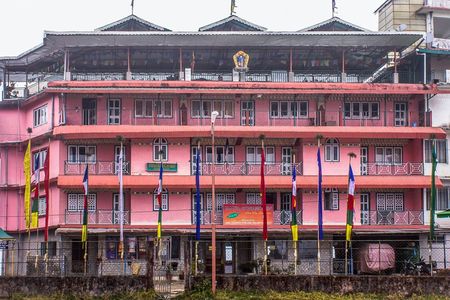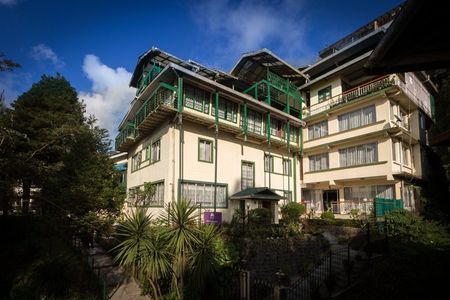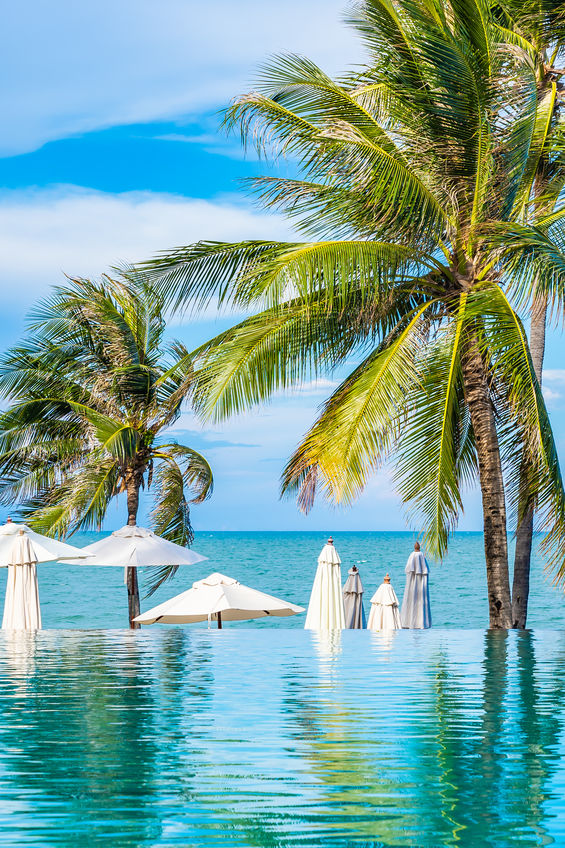
About the trip
The tour takes you to the hills of North East, High into temperate forests, oaks give way to laurels, chestnuts, maples, birch, magnolias and rhododendrons. Some 200 species of ferns, mosses, vines and lichens form thick undergrowth. Sikkim is world renowned for its orchids with almost 1000 species in and around Sikkim, Darjeeling and Kalimpong.
Accommodation

Summit Norling Resort & Spa
3 nights in Gangtok

Jain Group Hotel Sonamchen
1 nights in Pelling

Mount Himalayan Resort
2 nights in Darjeeling
Included in the price
Gangtok
- Transfers
- Sightseeing Tour
Gangtok
- Transfers
- Sightseeing Tour
Day-wise Itinerary
ExpandDay 1: Bagdogra – Gangtok
- In the morning, board your flight to Bagdogra.
- You will be met upon arrival by our representative who will transfer you to a popular local restaurant for lunch (On direct payment basis). Later drive to Gangtok (5500 Ft /1677 Mts, 130 Kms / 05 Hrs).
- Upon arrival, proceed for check-in at your hotel.
- Overnight at the hotel.
Day 2: Gangtok
- After buffet breakfast, you will be driven to Rumtek Monastery (24 Kms), Ban – Jhakri Water Fall, Do-drul Chorten or Stupa.
- Rumtek Monastery: the seat of the Karmapa Rinpoche, head of the Karmapa sub-sect of the Kargyudpa order of Tibetan Buddhism. The new four-level gompa was designed as a replica of the Kargyudpa's head monastery of Tolung in Tibet. Rumtek's monks come from all over Sikkim, India, Nepal, Bhutan and Tibet. Thangkas and frescoes decorate the walls of this ancient monastery, renovated in 1960's. It has a school to teach the Tibetan language and the various aspects of Buddhism. Every year on the 10th day of the 5th month of the Tibetan calendar a religious dance festival is held in this monastery. A perfect
- symbol of the confluence of the past and present is Gangtok - the capital of Sikkim. Built on the flank of
- a ridge, Gangtok is at 5500 feet above sea level. The town's unique ambience derives from the happy blend of tradition and modernity.
- Ban – Jhakri Water Fall: Ban literally means forest or jungle, and Jhakri means healer. A Ban Jhakri is a mythical man, who exist only in folktales within the Nepali Community in Sikkim. Local beliefs that Ban Jhakri used to dwell in the forest and live in rock caves worshiping sprits. Any tale of Ban Jakri can be either good or bad, some believe him as evil person and some as good. A famous tale the Banjhakri is that, he used to pickup small children and takes them to forests to teach Banjhakri ways.
- Do-drul Chorten or Stupa: was built by the venerable Trulshi Rimpoche, head of the Nyingma order of Tibetan Buddhism, in 1945. Inside this Stupa, there are complete mandala sets of Dorjee Phurba (Bajra Kilaya), a set of Kan-gyur relics (Holy Books), complete ‘Zung’ (mantras) and other religious objects. Around this Chorten, which is one of the most important stupas in Sikkim, are 108 Mani-Lhakor (Prayer wheels). These prayer wheels are turned by the devout Buddhist while chanting “Hail to the jewel in the Lotus”, to invoke the Buddhisattva. The Chorten is surrounded by Chorten Lakhang and Guru Lhakhang, where there are two huge status of Guru Rimpoche (Guru Padmasambhava).
- Just beside Chorten you will see Sikkim Research Institute of Tibetology.
- Sikkim Research Institute of Tibetology (SRIT) - The most prestigious of its kind in India – this Buddhist Institute is a treasure trove of vast collection of rare Lepcha, Tibetan and Sanskrit manuscripts, Statures and rare Thankas (Tapestries used in Buddhist liturgy) and has over 200 Buddhist icons and other prized objects of art. Today, it is a renowned worldwide centre for study of Buddhist Philosophy and religion.
- Visiting hour: from 10 a.m. – 4 p.m. (opened throughout the week and Govt. Holidays).
- Then visit Directorate of Handicraft & Handloom & last end your tour visiting Flower Show.
- Directorate of Handicraft & Handloom: Instituted with the aim of promoting and keeping alive the State’s traditional arts and craft, the Directorate of Handicrafts & Handloom is a storehouse of handwoven woollen carpets with traditional motifs, blankets, shawls in Lepcha weaves and exquisitely-carved ‘Choktse’ or table and many other gift items.
- Flower Show: Flower exhibitions are organised round the year at the Flower Show Venue near the White Hall Complex, Gangtok.
- Evening will be free for leisure and own activities.
- Overnight at the hotel.
- Meals: Breakfast & Dinner
- ________________________________________
Day 3: Gangtok
- Post breakfast depart for excursion to Tshangu Lake.
- Tshangu Lake: situated at a height of 12400Ft / 3780 Mts / 43Kms in 3Hrs one way, with an average depth of 50 ft. The cool water of the Lake is perfectly attuned with the scenic beauty around.
- Tshangu Lake is one of the most popular destinations for tourists; it is located at 35 km from Gangtok. On the way to the Lake, one can enjoy nice scenery and snowed hills. The Lake is situated at an altitude of 12,310 ft. has an average depth of 50 ft. and remains frozen during the winter months.
- Tshangu Lake, is cool placid water harmonies with the scenic beauty around which doubled by its reflection in the lake. During the winter season the lake becomes frozen. A temple of Lord Shiva is constructed on the Lakeside. Lake has average depth of 15 meters; footpath along the lake takes one to a resting shed.
- Further 10 kms from Tshangu Lake on lays the legendary Baba Mandir.
- Baba Mandir: at an altitude of over 13,000 feet. It was built in memory of a soldier in the 23rd Punjab Regiment, who drowned in a stream near the spot. Legend says he later appeared in a dream to one of his colleagues where he requested that a temple to be built in his memory.
- Though long dead, people believe that the solider stands guard over them. It is said that his crisply ironed uniforms are mysteriously wrinkled at the end of the day. The most interesting part is that the Govt. has approved this legend and Harvajan Singh enjoys salary increment, promotion and even holidays. His salary is sent home to Punjab and once a year, he goes on leave to his home. A soldier of the regiment accompanies his uniform in the train to his hometown. People believe that by placing their slippers and a bottle of water here, they are cured of backaches.
- Overnight at hotel.
- Meals: Breakfast & Dinner
Day 4: Gangtok – Pelling By: Surface (127 Kms / 5 Hrs)
- After breakfast, depart Gangtok for Pelling.
- Pelling: located at a distance of 120 kms from Gangtok Pelling is another serene, mountain village which lies in the western districts of Sikkim. This village is situated at an altitude of 2000 mts (approx.).
- Pelling is a beautiful hill-station, nestled between the snow-covered peaks of Sikkim. Located at a distance of 10kms from Geyzing, Pelling is renowned for being the nearest site to Mt. Kanchenjunga. The scenic beauty of Pelling cannot be circumscribed in words and really requires a proximate look to feel the quietude. Elevated to the height of 6,800 ft, Pelling is the best place to get a close view of the entire mountain range. It is for sure that you would certainly like to spend a quality time at this place amidst beautiful thoughts.
- Overnight at the hotel.
Day 5: Pelling – Darjeeling By: Surface (110 Kms / 5 Hrs)
- After breakfast, proceed for half day sightseeing to Rimbi Waterfalls & Hydro Project, Kechopari Lake (30 Kms / 6000 Ft / 1829 Mts).
- Rimbi Waterfalls & Hydro Project: About 12 kms away from Pelling and about 5 kms further down from Darap village is Rimbi River Bank which falls on the way to Khecheopalri and Yuksam where the main attractions are the river, water falls, oldest Hydel power station, Sewaro rock garden and the village.
- Water falls is spectacular in summer that attract many waterfalls lovers, The power station by name Karchen Power house is the oldest in west Sikkim which was made in early 70's during the last king’s government which successfully supplied energy to the most villages and towns of West Sikkim including Gazing ,Tigjuck and Pelling. River is beautiful and breath taking but it is only in the winter when river water decreases and becomes gentle, the tourists with families go right inside the river bank and enjoythe river and local children are found doing fishing
- Kechoperi Lake: The importance of this monastery is because of the lake. The world Khachoedpalri means ‘The Wishing Lake’. It is one of the most sacred and holy lakes for the Buddhist. The water of this lake is placid and crystal clear. Not a leaf can be seen floating on the water surface although it is surrounded by beautiful dense forests. Myth has it that whenever a leaf drops on the surface of the water, it is picked up by a bird.
- Afternoon transfer to Darjeeling (7380 Ft / 2250 Mts, 110 Kms / 05 Hrs.)
- Darjeeling: Standing high in the Himalayas at an altitude of 2134m, ‘Dorje Ling’, or place of the Thunderbolt, offers breathtaking views of snow-capped mountain peaks, with the Kanchendzonga rising higher than all the others. Often referred to as the “Queen of the Hills”, it remains just as alluring with its tiny waterfalls, little villages and a narrow gauge railway track. Surrounded by World Famous Tea Gardens and snow capped mountains, Darjeeling remains one of the most exotic destinations. Graeme Westlake in his book ‘An introduction to hill stations on India’ refers to Darjeeling as having “A view Scarcely Unrivalled on Earth”.
- Upon arrival at Darjeeling, check into your hotel and spend the remaining of the day at leisure.
- Overnight at the hotel.
- Meals: Breakfast & Dinner
Day 6: Darjeeling
- Early morning (approx. 4.30 AM), you will visit Tiger Hill before the break of dawn, to see the sun rise over Mount Everest, the highest mountain peak in the world (subject to clear wether).
- Tiger Hill: Darjeeling owes’ its grandeur to its natural beauty, its clean fresh mountain air and above all, the smiling resilient people for whom it is a home. Known for its natural splendour, Darjeeling’s best gift to its visitors is the dawn of a new day. The mountains awaken first with a tentative peeking of the sun. A steep ride, five kilometres from Ghoom, or an invigorating walk up a steep incline, leads sun worshippers to Tiger Hill. The air is chilly with darkness and damp.
- To the east, a dull orange sun emerged painting the sky with brilliant strokes of magenta, gold, orange and fuchsia. The snow capped Everest, Kabru, Kanchenjunga, Jannu and other peaks slowly emerge from slumber to start a new day. The sun worshippers gasp at the magnificent sight. As the fog lifts in the slowly penetrating sun, the town gradually comes alive. Amidst brewing of tea, the sing-song Gorkhali which is the local dialect, rises and falls like music.
- On your way back stop at the Ghoom Monastery, the holiest monastery in Darjeeling and Batasia Loop.
- Ghoom Monastery: Called Sakya Monastery, the monastery in Ghoom is located 8 km from Darjeeling. Sakya monastery is a historic as well as significant monastery of the Shakya Order. The original monastery was built during the early twentieth century.
- The monastery can accommodate around sixty monks. The statue of Maithreya Buddha (meaning “The Coming Buddha), which is 4.57 meter high, of this monastery is of interest here. The monastery also preserves some of the rarest Buddhist manuscripts.
- Batasia Loop: The Batasia loop situated almost 5 km away from the town is a gigantic railway loop where the Toy Train makes a 360 Degree turn. It was basically built to make it possible for the Toy Train to cut the deep ascend. Strategically located the Batasia Loop offers a panoramic view of the Kanchanjunga Range.
- Return to hotel for breakfast.
- After breakfast, you will be driving to Japanese Temple, Peace pagoda, Himalayan Mountaineering Institute & Padmaja Naidu Himalayan Zooogical Park.
- Japanese Temple, Peace pagoda: The Japanese Temple also known as the Japanese Pagoda is a popular tourist attraction of Darjeeling. The white architectural creation adds to its beauty. Locally known as Nipponzan Myohoji Buddhist Temple, it is situated close to the Peace pagoda in the town. A short drive from the centre of the town through shady hilly trails takes travellers to this temple.
- The prayer hall in the pagoda preaches words of spirituality, peace and wisdom through its prayers and chanting. On a clear day views of the Kanchenjunga can be breathtakingly beautiful. The place is surrounded by dense forest and is ideal for meditation.
- Himalayan Mountaineering Institue & Padmaja Naidu Himalayan Zooogical Park: Situated on Jawahar parbat about 02 kms from Chowrasta, this unique institute trains mountaineers. It has a museum containing an interesting collection of mountaineering equipment. Adjacent to the Himalayan Mountaineering Institute, it is a high altitude wild life parkland new home for Siberian tiger, Himalayan Black Bear, Deer, Red Panda, snow leopard and Birds.
- The snow leopard breeding center was started in 1986 to breed snow leopards in captivity with the help of international snow leopards in Captivity with the help of international snow leopards captive breeding project.
- Later visit the Tibetan refugee help centre.
- Tibetan Refugee Help Centre: is a rehabilitation centre for the Tibetan refugees in the Darjeeling Himalayan hill region. It was established in 1 October, 1959. During the great escape of the Dalai Lama, many Tibetans had followed His footsteps, leaving their homes. For that reason a self help rehabilitation centre had been started.
- The production of Tibetan handicraft is the centre's main activity where you would see how this refugee camp supports the homeless understand that no help can substitute self-help.
- Later return to your hotel or walk around the streets of the colonial city Darjeeling.
- Overnight at the hotel.
- Meals: Breakfast & Dinner
Day 7: Darjeeling – Bagdogra by: Surface (90 Kms / 4 Hrs)
After early buffet breakfast you will be transferred to Bagdogra airport to board flight back home.
Exclusions
Expand- Medical expenses and insurance of any kind. Meals not specified in the itinerary. Tips, laundry, liquors, wines, mineral water, telephone charges, camera fee and items of personal nature. Transportation is not on disposal basis. It is strictly as per the programme, any extra running will be charged extra. All the arrangements for the tour are pre planned and prepaid. In case of non-completion of the tour due to any reason whatsoever there will not be any refund for any unutilized services. Any extra expense due to the same has to be paid extra. Any expenses arising out of unforeseen circumstances like flight delay / cancellation / hike in fare, strike or any other natural calamities or any emergency evacuation expenses. Any other item not mentioned in the cost includes section.
Terms and Conditions
Expand- Rates & Rooms are subject to availability

